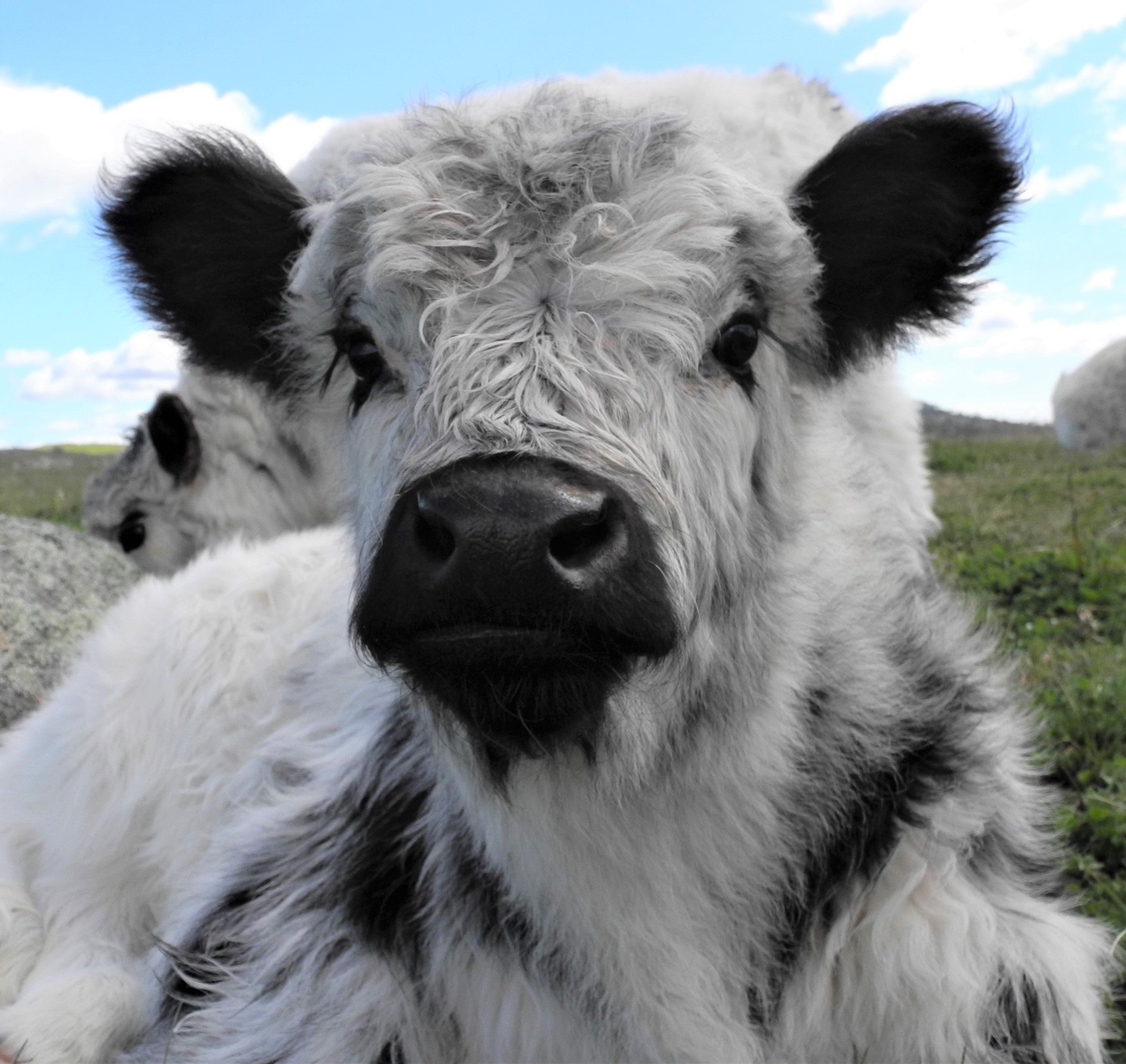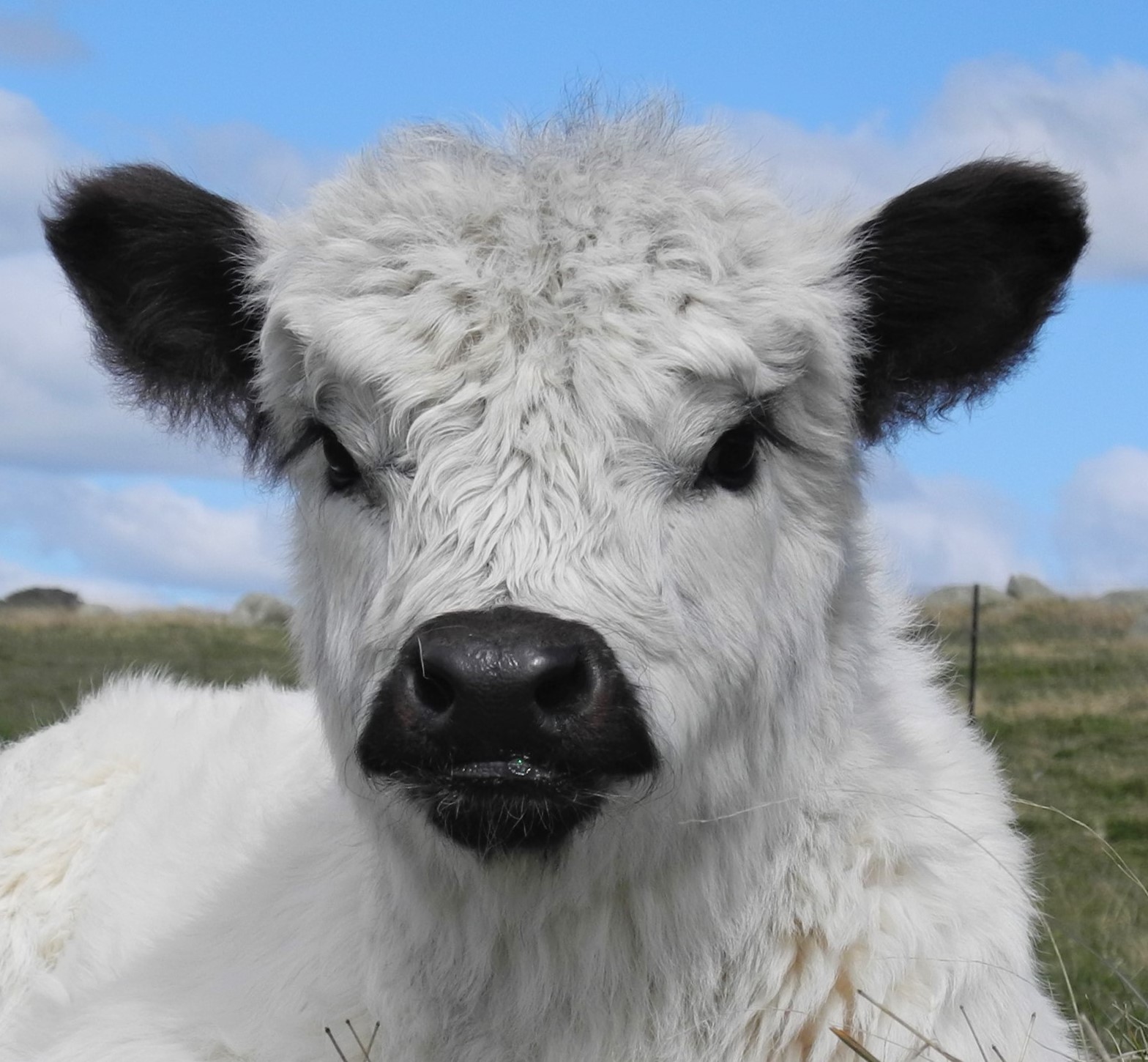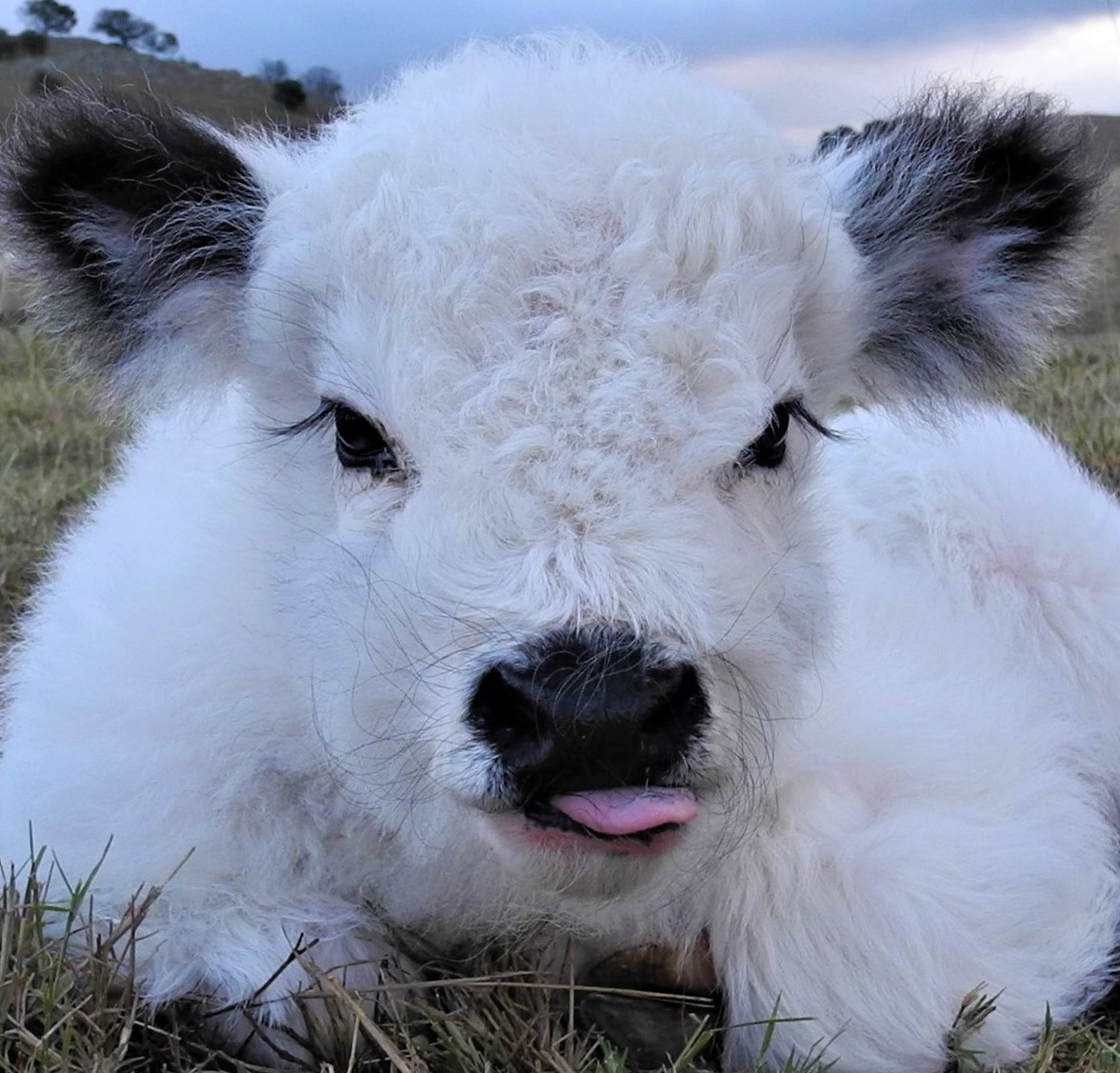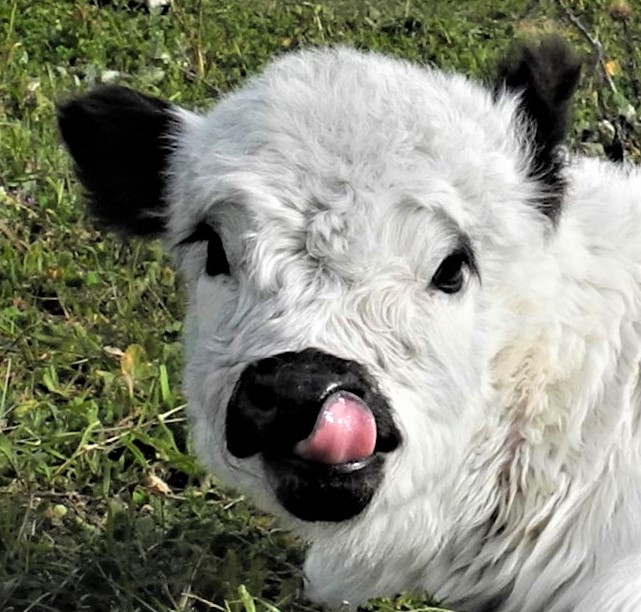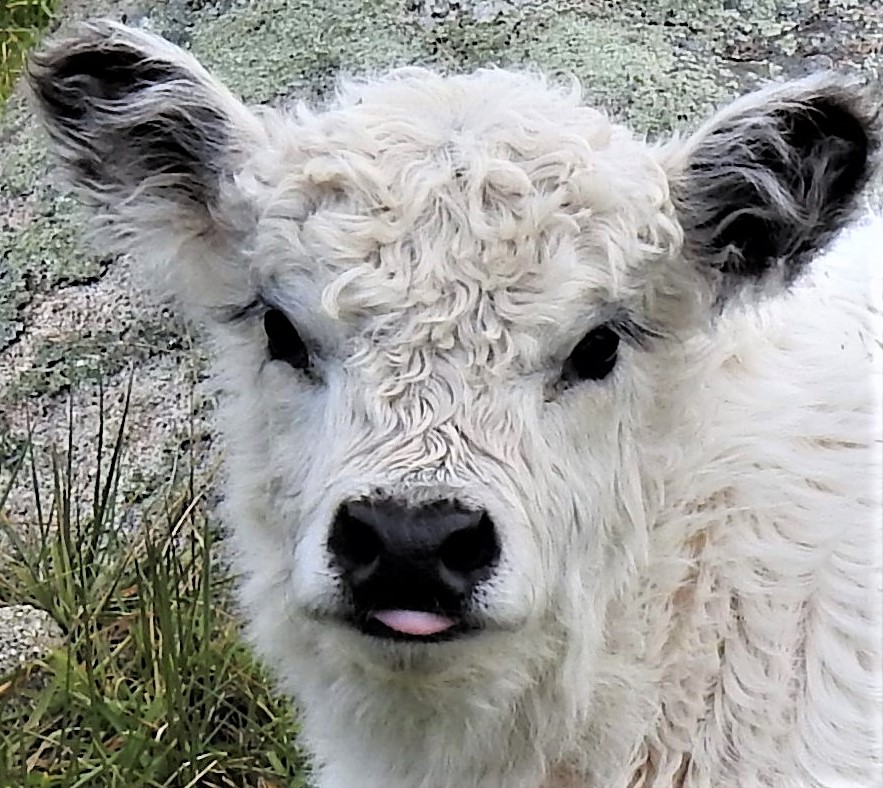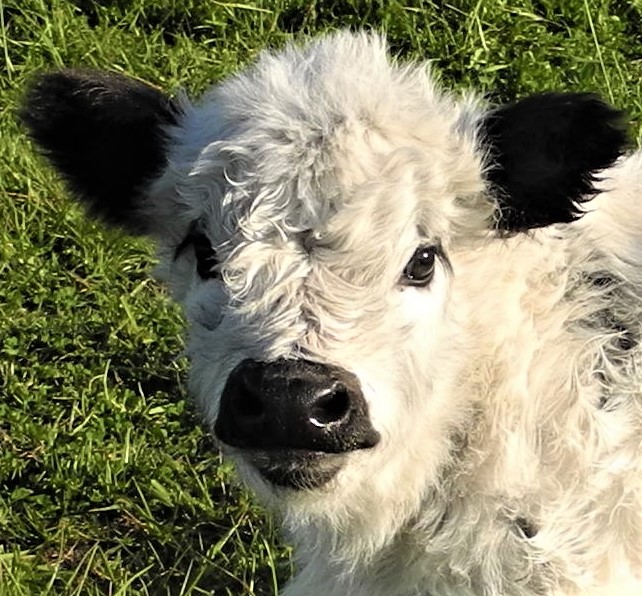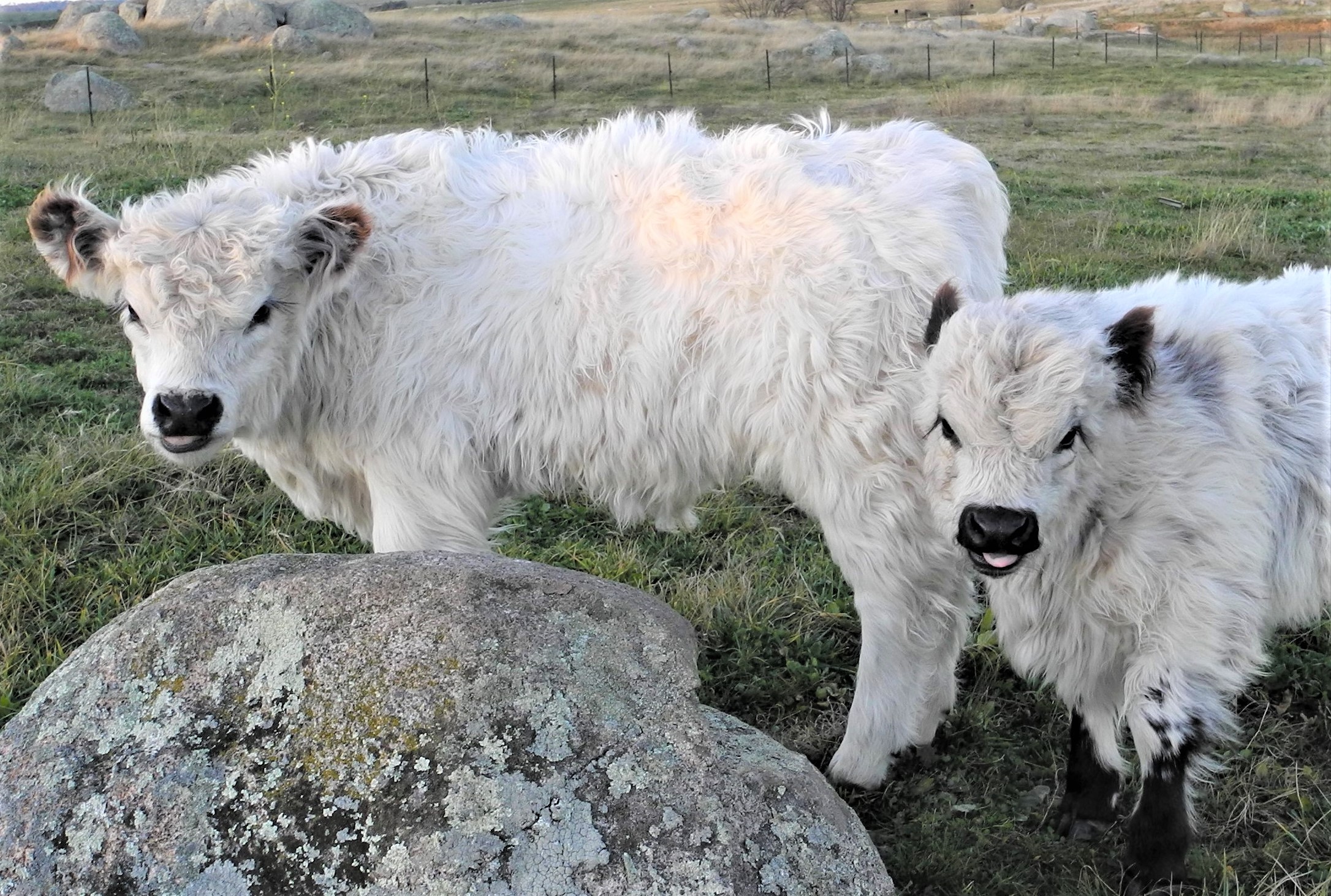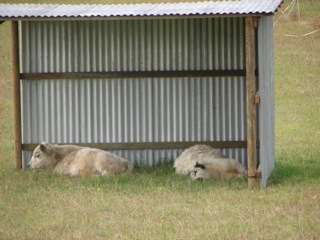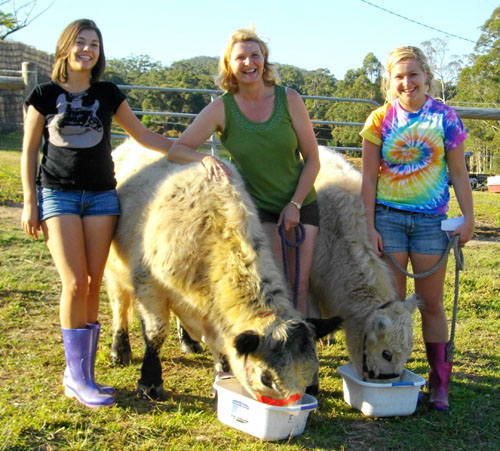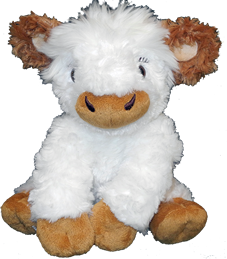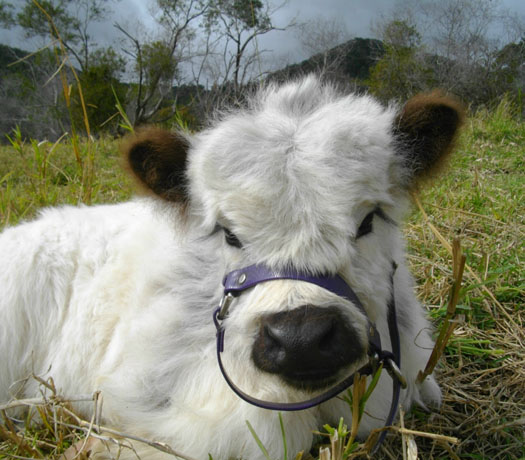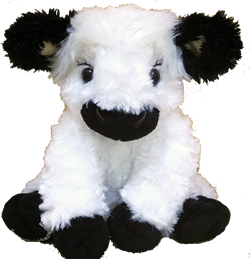cattle buyer information
Buying livestock from anyone for the first time is a huge undertaking for first-timers and old hands. We understand this, and we are willing to help people in any way we can. Selling cattle is not our first priority - we are not interested in giving anybody the 'hard sell' routine.
Our First Priority
Our first priority, when we offer stock for sale, is to place our miniature cattle into what we hope to be ideal situations. Ideal situations - great people in good locations. To date, we believe our success rate to be 100%.
We breed these beautiful animals for the sheer pleasure of it. We also simply enjoy promoting these amazing, docile cattle. Therefore, we are more than happy to help introduce these cattle to as many people as possible.
Buying Cattle for the First Time
Please read Calves as Pets and Caring For Miniature Cattle if you want to know a little of what is involved in keeping miniature cattle as pets.
If you are not quite ready to buy we encourage you to visit as many different cattle properties as possible and get feel for what best suits your needs.
Buying Cattle From Interstate - Please Note
If you live somewhere other than NSW, please try to find a breeder closer to you first. There are great miniature Galloway breeders in all the eastern states. Transporting cattle long distances really is not ideal for the well-being of the cattle or your bank balance.
If you live in Queensland and are thinking about buying cattle from interstate (from tick-free areas) please be aware that you will need to take preventative measures to protect these new cattle from the cattle ticks in Queensland, Tick Fever and paralysis ticks. Go to Caring For Miniature Cattle to find out more.
Buying Seriously Quiet Cattle
If you are particularly wanting to buy seriously quiet cattle and you would like some tips on questions to ask and what to look for go to Our Seriously Quiet Cattle.
Contact Us: Use the Contact Us button to make initial enquiries about the miniature cattle of interest to you. If you provide us with a home contact number, in your email, we can phone you at a nominated time and answer all your questions.
We do not expect anyone to buy miniature cattle they haven't seen, from people they haven't met. Please make arrangements to inspect our miniature cattle and to meet us in person. If you wish to visit our stud please go to Cattle Stud Visits for further details and other important information.
Conditions of Sale: Selling our cattle is not our first priority. We do not sell our miniature cattle unless we are 100% certain they are going to a place where they will be well looked after and given a 'fair go'. Our first priority is finding our cattle really, really, good homes. See Fair Go Farms for details.
Pick Up & Delivery: Our miniatures will walk on and off your horse float or stock trailer - no fuss. We can recommend good transport to other areas in NSW and Victoria.
The Cattle Buying Process
We direct you to this information to protect you from disappointment. Sadly, for the buyers, there are always more buyers than there are Miniature White Galloway cattle for sale. We are happier when these things do not end in disappointment or tears (and there have been tears). Our cattle are only withdrawn from sale when a deposit is paid and the receipt is sent to us. No exceptions.
Interest is always strong, by the time we are ready to offer any animal for sale we usually have 'spoken' to quite a few people by email. So, we already know a number of people who are well prepared to look after these cattle and who are ready, willing and able to pay a deposit the minute any cattle are offered for sale. When we settle on a leaving date and a price, we send emails to all of those people letting them know we have decided to sell and give them the price. After that, it is up to the buyers.
The holding deposit is 20% of the price. Members Equity Bank BSB: 944-300 Account: 007811578.
The minute we receive an email with a bank receipt for the deposit we withdraw the cattle from sale. Then we email everyone to let them know the cattle are sold.
Although we can give you plenty of time and attention during the sales process, it would be very unusual for us to be talking to only one buyer at any one time. This is not sales hype - there are always other buyers ready to jump despite us not having a waiting list. Miniature White Galloway cattle are in high demand and there are still only limited numbers of them in Australia.
We will hold cattle for a maximum of 21 days from the payment of a deposit - unless other arrangements are made at the time of sale. Payment in full is made on or before pick up or delivery takes place during that three-week period.
If you choose to organise the transportation yourself, it is your responsibility to organise safe transportation of the cattle from our property to yours, in a timely manner. A holding deposit will not secure our cattle indefinitely. If the buyer cannot organise safe transport on the pickup date, we reserve the right to return the deposit. Imagine how disappointing that would be!
galloway family & friends
One of the many joys of breeding these beautiful little white cattle is the number of wonderful people we have been lucky enough to meet through our cattle. There is only thing that makes it possible for us to part with any of our little white fluff balls - the fact that we have managed to find just enough fantastic people to look after them.
Good Homes Great People
Every miniature that has left our property is now living somewhere just as good, if not better than here. Keep in mind that our property is known locally as 'cute cattle paradise'. All the miniature cattle that have left cute cattle paradise have great new homes and fabulous new families, and we have some great new friends.
Check it Out For Yourself!
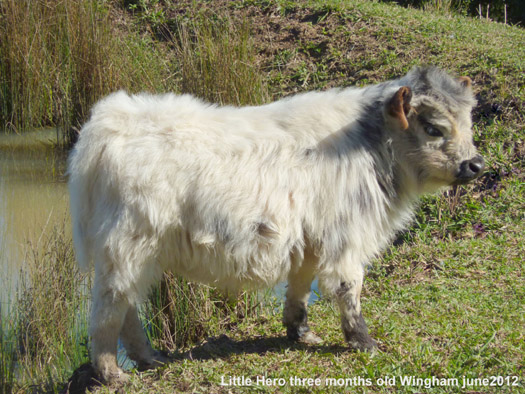
The littlest, bestest, sweetest bull in the whole wide world - yes a biased opinion!
Bruno and Cooper just loooove their new 'shed'. They are so relaxed that Robyn periodically has to check they are still breathing! The good life. Grafton June 2012.
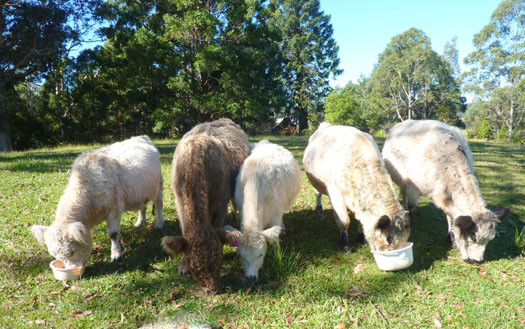
Roll call at Wingham - Toto, Nutmeg, August, Banjo (bull) and Grace. May 2012
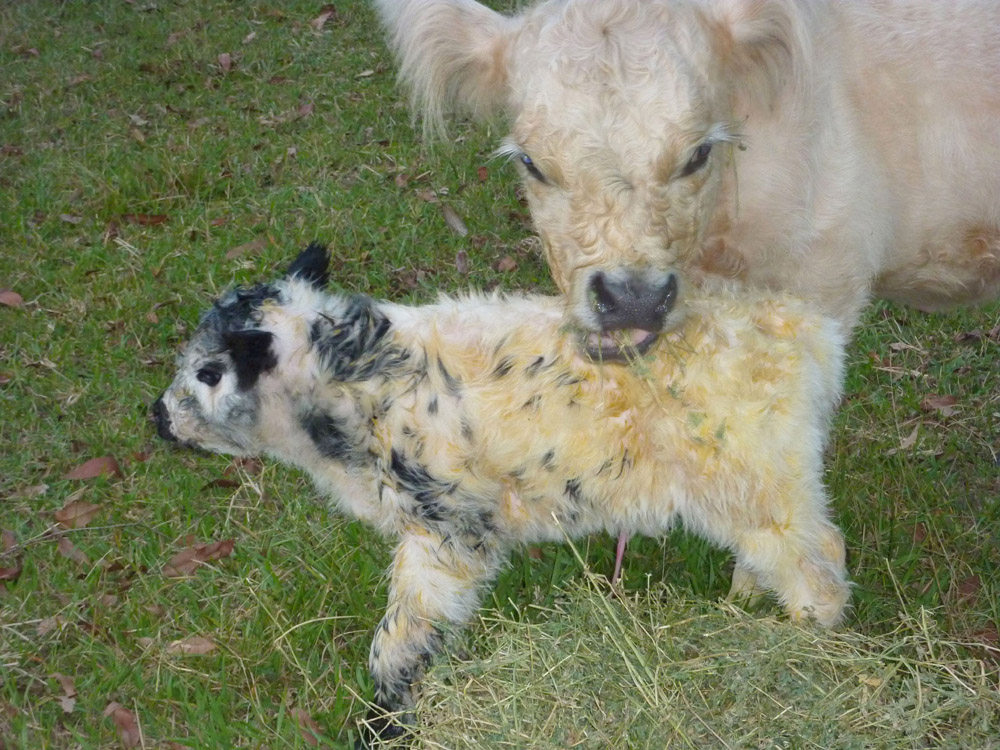
Toto has him clean and is enjoying a well-earned biscuit of hay. Hero is so small.
It is all happening in Wingham - 9 March 2012. One very determined little heifer managed to fall pregnant far too young - causing everyone great anxiety. After months of worry, all's well that ends well. A very healthy bull calf (and one very young new Mum 'none the worse for wear'). We think Hero is the smallest bull calf to date. We will get him measured shortly.
The local vet checked in on them three days later and gave everyone a clean bill of health. He said he had never seen such a small calf. Lesley is so taken with her new little mate she can barely tear herself away from him to go to work!
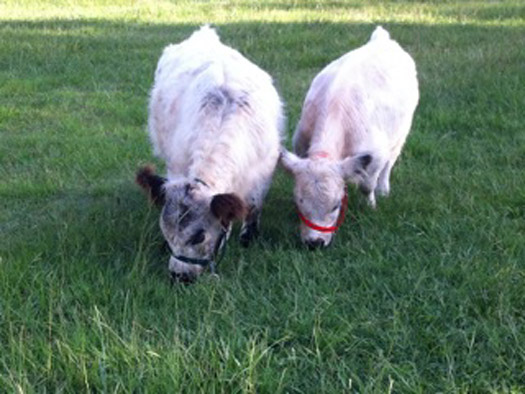
Bruno and Cooper happy in their beautiful new home near Grafton. Feb 2012
New owner Robyn is another first-time livestock owner. Robyn waited for what seemed like a long time for her two little boys and she so pleased with them: "My two new mates are doing so-ooo well! This is, of course, due to their fabulous upbringing with you, for which I thank you. They have now checked out the whole paddock they are in and appear quite content."
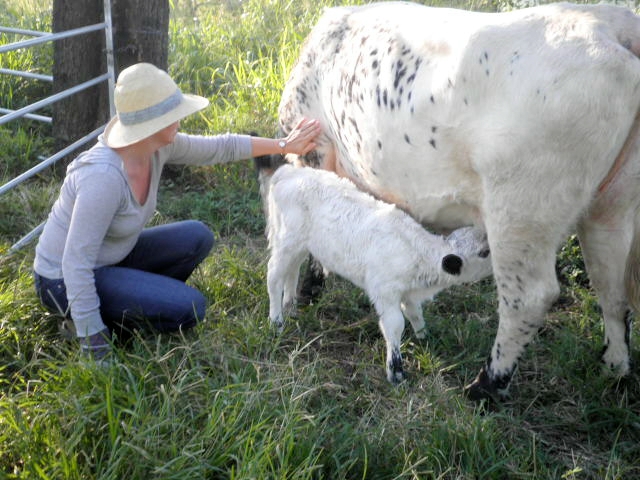
Sandra gives Magic a love - Magic is feeding one day old Sparkle. April 2011.

Julia telling Magic how clever she is one week later. Sparkle waiting for her turn.
The family at Habana (near Mackay) has a little mini herd. Sparkle is the second calf their beautiful Wee White cow Magic has given them. Max, their little white bull is very proud of his efforts. Julia and Sandra are pretty pleased too.

Jack enjoying the shade with Pink Persil and Poppet at Kilcoy - 2010.

Cloud - Persil's handsome 5 mth bull calf at Kilcoy - in April 2011.
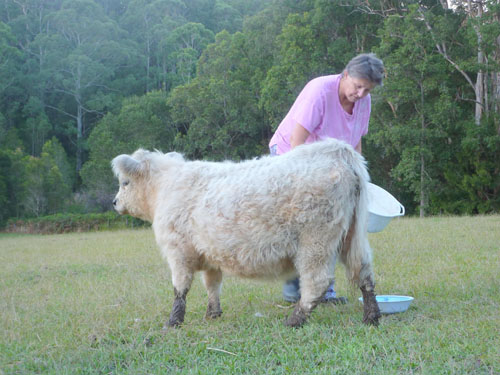
Lesley is giving Toto a brush and a treat. Wingham. March 2011.

Here's the miniature pig fast asleep, curled up with the little bull. Brisbane 2010
It was all smiles when Banjo and Casper arrived at North Arm - 2009.
Feedback from People Owning Miniature Cattle
Periodically, we check in with the wonderful people who take our miniature cattle home with them. We like to find out how their new family members are settling in.
Here is some feedback we received during 2012.
From Elland in NSW: My two new mates are doing so-ooo well! This is, of course, due to their fabulous upbringing with you, for which I thank you.
Here is some feedback we received during 2011.
From Bangholm in Victoria: I found their favorite spot to be brushed is under their chin and neck. Love, love, love them.
From Wingham NSW: Just up with the chooks to find Grace and Banjo relaxing in the sun and clearly amused by the chook's antics, its one of their fave spots. Banjo would be so easy to spoil ... can you get choc dipped lucerne? xx
Here is some feedback we received during 2010.
From Crystal Creek in NSW: My boys are so beautiful and I love them so much. They know my voice and come running when they see me... I bring the treats. I love them to bits and they give me great joy and the kids that come out to the farm love them as well.
From North Arm in Qld: Our little boys are divine and we love them both. I am not into favourites, as I love all my pets equally, but Banjo is a little treasure, absolutely everything about him is perfect. My boys are perfect ...the boys have been a wonderful addition to our family.
From Kilocy in Qld: Elliot and his lady friends are very happy munching through their waist high grass. He is awfully fat at the moment. He is still as lovely as ever, and makes our time with the cows very precious.
From Brisbane in Qld: Tiny rules the roost. She and the alpacas and pig graze all day. They are the best of friends. We often see Cow, 2 Alpacas and Pig, in that order, going everywhere together. They are never more than a few metres from each other. In the afternoon they all head up the top of the property and put on a show for all the neighbours and kids walking home from school.
The friends and family grows. More pics as they come in.
caring for miniature cattle
Owning miniature cattle has proven to be one of the best decisions we have made in a long, long time. If you are a first time livestock owner, you will learn as you go - we certainly did. At times the learning curve will seem steep but eventually it will all become second nature. A pattern will evolve where you just know what you need to do for your miniature cattle and your cattle will know what they need to do for you. Cattle love a routine and a bit of peace and quiet - just like us really.
Starting Out
Â
Which One to Choose - Bulls, Cows, Heifers or Steers?
The following information is provided for first time livestock owners as a starting point only.
First and foremost, think carefully about why you want miniature cattle. What do you expect from the cattle? What kind of cattle do you want and why? Have you considered what the cattle will need from you? What are you prepared to provide your cattle to keep them happy and healthy. The lifespan of well looked after cattle can be 20 - 25 years or much more. So it is worth a bit of thought.
To begin with, you need to appreciate that cattle are herd animals, so you need to have at least two. Some miniature cattle are content to be paired up with other animals - sheep, alpacas, goats, donkeys and even miniature pigs. Other miniature cattle are better suited to being part of a herd of cattle (even if it is a small herd).
Steers:Â Castrated male cattle (testicles removed). Usually castrated quite young so that the little fellow remains small and docile. We generally recommend a couple of steers for first timers.
Heifers: Young female cattle that have not had their first calf. We recommend heifers to people wanting to enjoy the little girls now while they 'learn the ropes'. Then they can enjoy their new calves a bit later on.
Cows:Â Mature female cattle that have had their first calf. We generally recommend cows to people who want calves sooner rather than later. Buying the cow pregnant is a good option.
Bulls: Male cattle that have not been castrated. We don't recommend bulls to first timers, unless you want to breed and have at least a small herd.
Steers, if you get them at six months old, are the easiest to manage. Steers don't go looking for cows or heifers in season (also called 'cycling' meaning the female is hormonally ready to join with a bull). If you have cows and bulls you will soon discover that their drive to join with a mate can be very strong and usually very inconvenient. Your neighbour will only ring you at the most inconvenient time to let you know that your bl#@dy bull is in with his show heifers! (Or worse - out on the road!!)
So, unless you have enough cows to keep a bull entertained you are better off making other arrangements (no, as a rule one or two cows won,t do it!). There will always be exceptions to any rule and our little bulls are proving to be quite content to stay exactly where we put them. As long as they have the company of at least one steer, our little bulls seem fine.
Also, unless you are able to borrow a bull or pay to have your cows artificially inseminated, a cow that is cycling may go wandering in search of a bull. They usually don't wander quietly and they can be very determined. Again, there are always animals that seem perfectly content regardless. Our females have not gone through a fence or caused a big fuss to date (touch wood).
Our Galloway cows are renown for ease of calving. If you want to experience the joy of your very own calves there is no reason why you should not buy some 'girls'. Make sure you will have enough feed for the calves as they grow and that you have a plan for their future. You need to know what you are going to do with the calves by the time they turn six months old.
Some miniature cattle mature very early - both bull calves and heifers. You may need to separate males and females at a young age to prevent unwanted pregnancies. To avoid calving problems, it is a good idea to let little heifers grow out a bit before allowing them to join with a bull.
Caring For Miniature Cattle - The Basics
Again, this information is provided for first time livestock owners as a starting point only. Basically, miniature cattle need pasture, shade, fresh water, ongoing care and regular contact with their owner.
Pasture:Â Pasture is the mixture of different grasses, legumes etc that are in your paddock. The greater the variety of grasses and legumes in your paddock the better the nutritional value the pasture has for your cattle. It is probably wise to seek local knowledge on the type of lantana and other weeds you may have on your property that are poisonous to cattle. Talk to your vet or a farmer who lives near you about these things.
Paddocks & Fences: You need at least three paddocks so that the pasture can be rested and the cattle get a fresh paddock regularly. Alternatively, if you only have one large paddock you can divide it into three. You can easily use inexpensive electric fencing to divide up one paddock. A small battery powered transformer and PVC tread in posts with a strand of poly wire is all you need. The transformer is no bigger than a 1 litre milk container and can be run on D cell or 12 volt batteries. Transformers are under $200 and the white tread in PVC posts are around $6. Too easy.
Boundary fences need to be well maintained and strong enough to contain your biggest, most adventurous animal. Four or five strands of wire, barbed or plain, with star pickets and timber corner posts and stays, should be sufficient. Most cattle won't test fences if all their needs are being met. Barbed wire is not necessary and is harmful to wildlife. If your fences already have barbed wire please consider replacing the top and bottom strand with plain wire - especially if it is evident that you have a wildlife corridor.
Shade:Â Shade means mature trees that the cattle can't wreck or at least a solid shade structure where cattle can get out of the sun in each paddock . Make sure the shade is always available in the middle of the day in every paddock. Our Wee White cattle have a double coat and don't need shelter from the cold, definitely not in Queensland anyway, but they do need shade. Shade for the cattle in the middle of the day is a must and it is a bonus if their water can be in the shade.
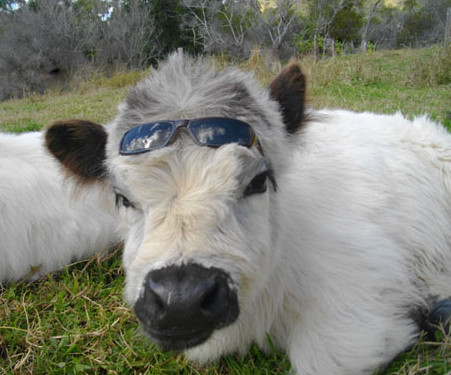
No, they don't need sunglasses but we do love to have a bit of fun in the paddock.
Fresh Water:Â Fresh water means that the cattle need a trough in the paddock that is monitored and topped up regularly or an automatic trough (you still need to check an automatic trough occasionally to see that it fills properly). Ideally the container needs to be deep enough for the water to stay cool or to be shaded in the heat of the day. If the cattle have access to a dam or pond that is fine - as long as you don't mind the water being fouled and the edges being eroded.
Contact and Care:Â At least once or twice a week, look carefully at your miniature cattle and run your hands all over them. By doing this you will remain familiar to your cattle and you will be able to notice when things change. You will be able to take note of the condition of the animal and their coat. You will also notice things like too many ticks, flies or odd behaviour.
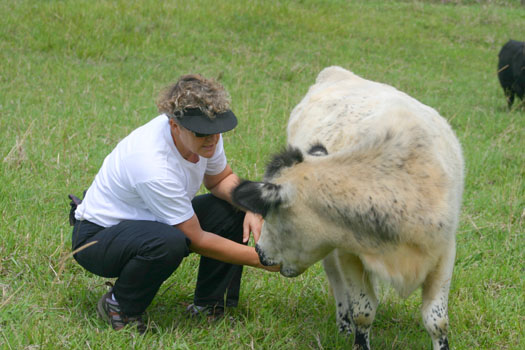
Check your cattle regularly and then you'll know when something is not quite right.
If you notice your miniature cattle are losing condition (getting skinny) you need to add extra hay or other feed to supplement their pasture. If they are getting too fat you might want to cut back on the extras or put them in a 'Jenny Craig' paddock.
The more time you spend with your miniature cattle to easier it is to train them, or to do anything else with them for that matter.
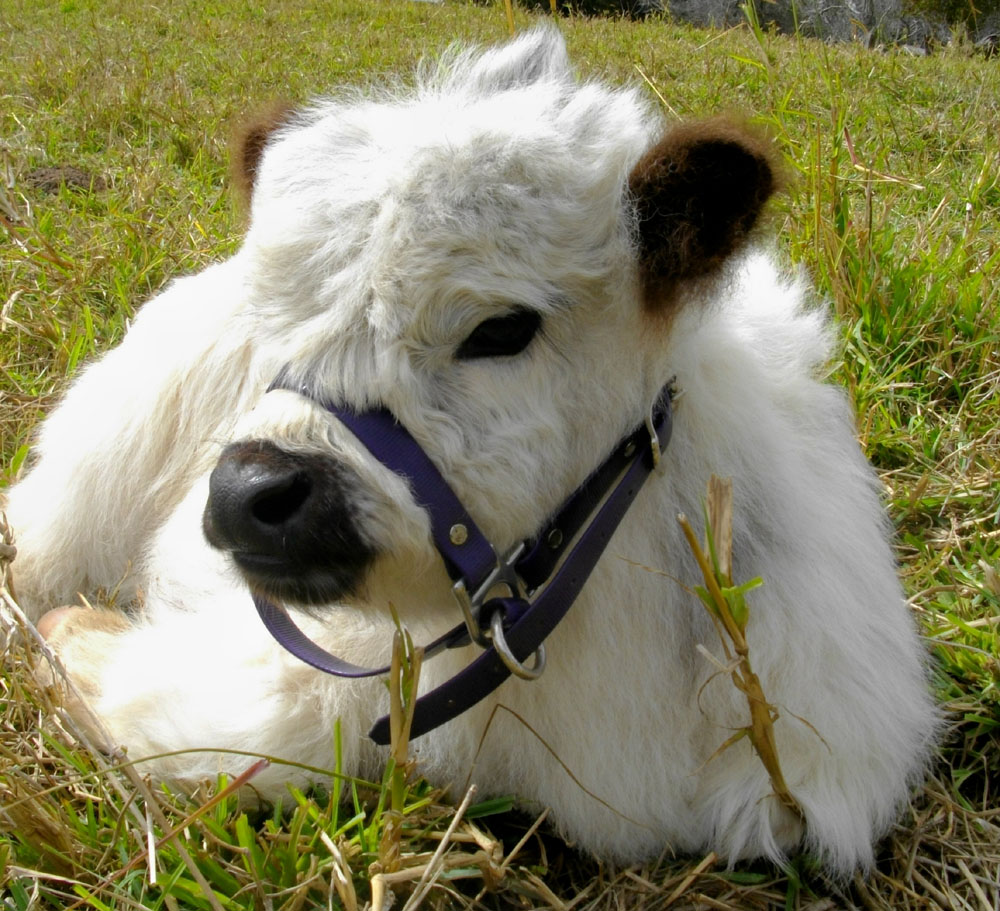
Halters are easier to introduce if calves are used to you touching their faces.
Cattle Ticks & Parasites: In the hotter months of the year, if you live in a tick zone, keep an eye out for the appearance of cattle ticks on your miniature cattle (most of eastern Australia). If ticks become a problem you will need to use a pour-on or spray product to control the tick numbers. Most of the pour-on products you use for ticks also treat internal parasites. So, even if you don't have ticks, the cattle will still need a product like Ivermectin, Cydectin or something similar periodically to treat worms and other internal parasites.
Nearly all tick products need to be applied every three or six weeks when ticks are in high numbers. With our cattle we simply walk up to them in the paddock and pur Cydectin along their back. This means no herding them into yards, no need for a crush and no hassles.
You can purchase smaller bottles (smaller than cattle stations use), of these products at Landmark, a produce store or the like. You pour a measured amount down the spine. There is a tape you can use (like a dressmakers tape) to work out the weight of the animal so you know the correct amount of pour-on you need to use. These tapes are also available from Landmark, a produce store or the like.
If you only have two miniature cattle and you brush them regularly with a slicker brush, a chemical tick treatment may not become necessary. We brush our cattle every few days, move them into a fresh paddock every two or three weeks and then slash the pasture behind them.
In January 2010 our cattle only had a couple of ticks on their ears after months of no other treatment. We were then hoping that during the next season we will only need to use Neem Cattle Wash to control ticks. Unfortunately extreme weather conditions in early 2011 put that on hold. Queensland experienced so much rain it was difficult to know what to do with the cattle most of the time. The cattle coped very well and we need not have worried but we did have to go back to using chemicals to control the outbreak of ticks that has followed.Â
Paralysis Ticks:Â Cattle ticks and paralysis ticks are two different ticks. Cattle tick products do not stop paralysis ticks from attaching. If you have very young, small calves (younger than 3 months old) check them for paralysis ticks just like you would a dog. Miniature Galloway calves are only the size of the medium and large dog breeds until they are 4-5 months old. You could rinse the calves in Fido Tick Rinse or Permoxin regularly to protect them from paralysis ticks until they are bigger. Or you could just put a tick collar on them. We do this in the drier months and it has proven to be very effective. Paralysis ticks won't kill larger calves but you still need to keep an eye on them and remove ticks when you find them.
Paralysis ticks can be found all along the coastal areas of eastern Australia. Where ever they are a problem for dogs they will be a problem for miniature calves.
Buffalo Fly:Â Again, in the hotter months of the year, look out for buffalo fly. These small flies hang around and irritate the cattle's eyes in particular - sometimes making them bleed. If they become a problem use a product like Brute, a pour on, works well for people with small numbers of cattle. You might be able to purchase a couple of ear tags from a neighbour who uses these to protect their cattle from buffalo fly.
If you want to use non chemical or organic alternatives there are a few available. We use and can recommend Neem Cattle Wash. We dilute it and spray it on (using a little 500ml kitchen spray bottle) to kill tick larvae, deter buffalo fly and soothe any skin irritations. We also use it neat on cuts, scratches, sores and bites. Check it out online. We use Lucas Paw Paw ointment on broken skin and the corners of eyes that have been bothered by flies. We have started using homeopathic drops for Buffalo Fly and are now waiting to see the results next season (homeopathic drops from Heal With Ease).
Ongoing Maintenance
Get to know other people in your area with cattle. We have found that  'cattle people' are really helpful people. They usually don't mind being asked what you might feel are 'silly questions'. If you can team up with a couple of other people, who also have miniature cattle, it can help immensely. You get the opportunity to share information, ideas, costs and worries.
Most of the annual vaccinations, injections and the like come in packs of 10, 20, 40 etc. So it is really helpful if you keep in touch with other cattle owners so you can organise to share these packs. Things like Cydectin come in many different sizes, but the larger the volume you buy, the more you can cut the cost per litre. Even buying twice as much and halving it with friends really helps to keep costs down.
More importantly though, by finding other people with miniature cattle, you get to share the sheer joy of owning these wonderful animals with other people, people who actually understand what you are so excited about.
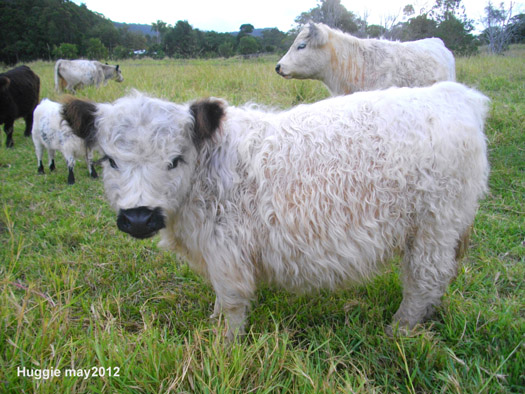
Vaccinations and Injections:Â Cattle need an annual 7 in 1 injection. The 7 in 1 injection is an immunisation against enterotoxaemia, blackleg, malignant oedema, black disease, tetanus and leptospirosis. You may choose to use other injections to solve other problems.
Bovine Ephemeral Fever:Â An annual Bovine Ephemeral Fever (BEF) injection will immunise your cattle against this viral disease of cattle and buffalo.
If you notice your cattle are moving stiffly or laying down and not getting up, then Three Day Sickness might be the problem. Typically, affected animals are only sick for a few days, hence the alternative name - Three Day Sickness. Three Day does not usually kill cattle and some people only immunise their most valuable herd members. If your cattle do come down with Three Day Sickness you will need to make sure they are in the shade and have plenty of water while they recover. You may have to take this to them if they are not moving (although they may not be able to drink as BEF can effect their ability to swallow).
We have recently used Heal With Ease homeopathic drops on a cow presenting with the symptoms of BEF and were amazed to see the results. The cow was down in the afternoon (unable to get up) when we gave her the drops. She was up and eating the next morning. See Cattle Links - Useful Links for the Heal With Ease website address.
Tick Fever: In Queensland we 'blood' our cattle (vaccinate them) against Tick Fever. The vaccine is inexpensive and can be sourced from the Tick Fever Centre Street address: 280 Grindle Rd, Wacol QLD 4076.
Tick Fever is a disease of cattle acutely infected with one of three blood-borne parasites that are carried by cattle ticks. If ticks can bite the cattle, the cattle are at risk. Cattle Tick pour on products will not protect your cattle from Tick Fever.
As a preventative measure, a dose of Imizol (also from the Tick Fever Centre or your local Vet). At 2.5 mL per 100kg live body weight a subcutaneous injection will protect cattle from Tick Fever for a four week period (Imizol is a good alternative when introducing to, or transporting through tick areas).
Once you have seen cow or bull suffering from Tick Fever, you can be sure it is not something you will ever want to see again.
Bringing Cattle Into Queensland
If you are bringing cattle into the state of Queensland (Qld) from areas where cattle are not exposed to cattle ticks orparalysis ticks please take special care.
Insist that the cattle are vaccinated for Tick Fever at least 4- 6 weeks before transporting them into Qld. If this is not possible, then inject the cattle with Imizol straight away. As a preventative measure, a dose of Imizol at 2.5 ml per 100kg live body weight given by subcutaneous injection, will protect cattle from Tick Fever for a four week period. Or watch the new cattle very closely for weeks/months, and at the first sign of lethargy, inject them with Imizol then.
Tick Fever is Deadly
For the treatment of Tick Fever the recommended dose of Imizol is 1 ml per 100kg live body weight given by subcutaneous injection. The injection site should be swabbed clean with antiseptic prior to dosing. Very severely affected cattle may require a second dose 24 hours later. Good nursing is also important including provision of shade and availability of water and feed.
Vaccinating cattle is not a guarantee that they won't get Tick Fever, but it gives them a good chance of survival if they do get it. It is not worth the risk of losing a single one of these beautiful bovine creatures to Tick Fever.
The organisms that cause Tick Fever are transmitted by the cattle tick and cause red cell destruction and pathology in numerous organs. Clinical signs may include fever, anaemia, jaundice, red urine and nervous signs; but these signs will vary depending on the parasite, its virulence, and the stage of infection. The disease is widespread in cattle tick-infested areas of northern Australia, including Queensland. Not all cattle ticks carry the parasite.
Paralysis Ticks Can Be Deadly Too
If you are bringing cows into Qld with young calves at foot, you also need to be very vigilant in checking the calves for paralysis ticks. Paralysis ticks will kill young calves (younger than 3 months). You could rinse the calves in Fido Tick Rinse (dog product that you can use every four days) or Permoxin (horse product that you can use every ten days) to protect them from paralysis ticks until they are bigger. Even if you use these products it is wise to run your hands over the calves daily (feel with your fingers moving against the direction in which the hair is growing).
It is not likely that one paralysis tick will kill a larger calf, but you still need to keep an eye on them and remove ticks when you find them. This is especially important if the cattle have come from an area where there are no paralysis ticks.  If a large number of paralysis ticks get on a larger calf and stay on that one calf, this may well kill the calf. Calves will look lethargic, lick their lips a lot, pant and go wobbly in the back legs when they have a paralysis tick on them. Take action immediately.
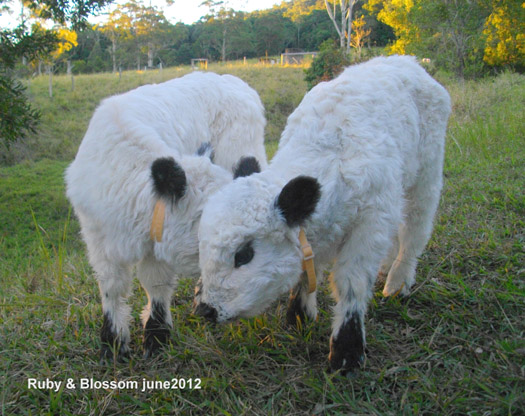
 Two weeks old with tick collars on to protect them from paralysis ticks (in June!)
Weaning Rings Look Cruel But Are Actually Kind
Weaning rings look terrible but we believe they are the kindest, least stressful way to wean a calf. Before we discovered weaning rings, calf weaning was always a stressful time for everyone - the cow, the calves and us! The mooing and bawling from calf and mother was heart breaking to listen to (sometimes lasting for several days). Despite the look of them, the weaning rings do not hurt the calf at all and they do not prevent them from grazing. The calf and the mother can stay together to comfort and groom one another during the weaning period. The ring just prevents the calf from suckling. We generally use the time to further bond with the calf by offering them molasses laced treats, extra brushes and lots of loving attention.Â
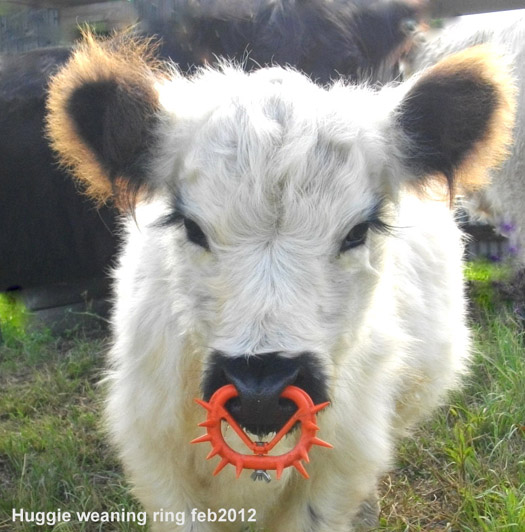
A heifer with a deadly looking weaning ring in her nose - looks cruel but is kind.
Reference Books: If you want further information on cattle care there are a couple of good books we have used and recommend often. Margo Hayes Small Cattle for Small Farms. Pat Coleby Healthy Cattle Naturally (now out of print but you can get Natural Cattle Care by Pat Coleby). Both books are less than $40 each.
if you would like more information on Caring for Miniature Cattle please This email address is being protected from spambots. You need JavaScript enabled to view it..Â
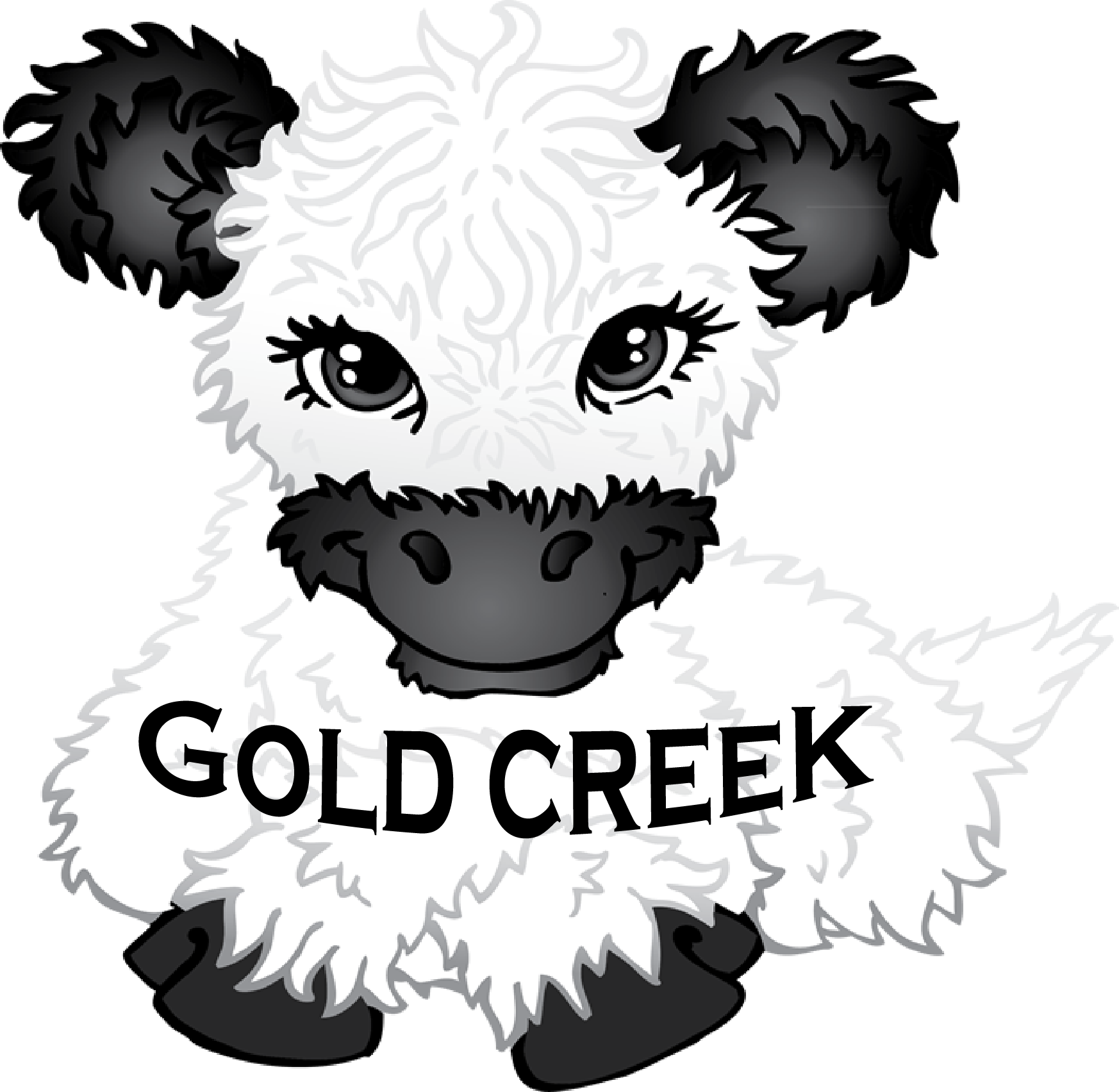 to see what's happening in 2023 go to
to see what's happening in 2023 go to 
To see the latest videos go to our GOLD CREEK YouTube channel.![]()
our pure bred galloway
Like the full bloods, the number of pure bred Miniature White Galloway cattle in Australia is also small. There is in fact an even smaller number of pure bred Miniature White Galloways registered as Active with the Australian Galloway Association. We aim to significantly improve on that number.
Top Quality Pure Bred Cattle
To increase the numbers of pure bred cattle we have embarked on a very ambitious pure bred Miniature White Galloway breeding program. It is our aim to breed the ultimate pure bred Miniature White Galloway, with every generation genetically screened.
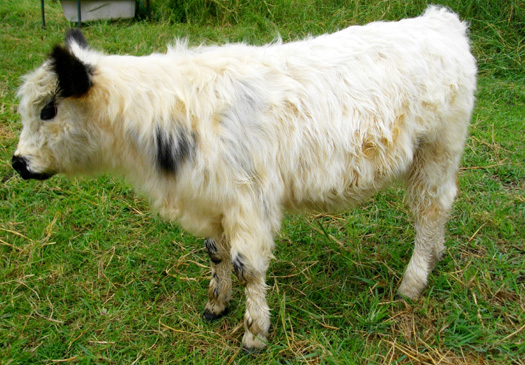
A 2009 Pure Bred heifer at 12 months. Gold Creek Echuca is a Cannon Boy calf.
Our aim with this breeding program is to have top quality, small pure bred cattle. Miniature cattle that, through our meticulous pure bred breeding program, can eventually be registered as pure bred Miniature White Galloways. These will be pure bred Miniature White Galloway cattle that can claim top quality genetics. To achieve genetic excellence we have chosen to use only the best pure bred cattle from one other breed of very small cattle. This has enabled us to trace the breeding genetics of both the sire and the dam of every single generation (in almost all instances). This is just one of the many steps we take to ensure that our cattle achieve genetic excellence.
Every year the progeny of each generation is listed and their details are recorded by the Australian Galloway Association. The progeny can only be registered as pure bred when they reach the Australian Galloway Association pure bred standards.
The Technical Details
Technically speaking, until the cattle in our breeding program reach pure bred status, they are referred to as Miniature White Galloway listed 'grades'. To be clear, the details of graded cattle are 'listed' or 'recorded' with the Galloway Association, as opposed to being registered (as is the case of full blood and pure bred cattle). Even Miniature Galloway cattle registered as 'pure bred' continue to have the letters GRD (grade) recorded as part of their ancestral code. So again, technically speaking, all pure bred Galloways are grades.
All bulls used in any Galloway pure bred breeding program, including ours, have to be DNA tested. Their DNA and their breeding details must be recorded with the Australian Galloway Association and bulls must test free of certain diseases. The breeding details of all females also have to be recorded with the Association and cows must test free of certain diseases for the breeding program to be legitimate.
All cattle registered or recorded with the Australian Galloway Association, including ours, are on public record. These records can be viewed online or verified by simply contacting the Australian Galloway Association. For more detailed information on the grading up process go to: Galloway Pure Bred Program in the side menu.
When We Were Starting Out
Miniature White Galloways are, in our opinion, the best breed of miniature cattle in Australia. However, they were not the smallest or the most readily available of the miniature cattle breeds when we started out. The size issue has changed in recent years with established breeders in both Queensland and New South Wales having recently bred much smaller full blood and pure bred Miniature White Galloways. It is still difficult to purchase pure bred, Miniature White Galloways - especially females.
When we started out full blood females of any size were difficult to come by and we wanted to build up our herd numbers. We also wanted to bring down the size of the individual herd members, while still retaining all the good qualities of the Miniature White Galloway. First and foremost we wanted the smaller Miniature White Galloway cattle in the pure bred breeding program to be a stand alone animal of high value right from the very start.
The calves in our pure bred breeding program are small, white and have black points - ears, eyes, nose and hooves. To date they all have beautiful white, medium or full length coats. From the outset they were smaller than our full bloods, and just as docile and friendly. The 2011 calves seemed impossibly small at birth, but they are all growing up strong and lively.
The sweet nature of the liittle 2011 heifers is proving to be very popular with visitors. In fact as 2012 rolled along, it was proving difficult to keep them here - everyone wanted to take one home with them! After waiting so long for them we are very reluctant to part with any of them just yet.
We are hoping to join these heifers with our small full blood bull Nemo by mid 2013. If all goes to plan 2014 will see our first born and bred GOLD CREEK pure bred Miniature White Galloways.
The Future
As our breeding program progresses, we become more and more impressed with the progeny of these smaller Miniature White Galloway graded cattle. There will be great excitement the first time we are able to register our very own Pure Bred Miniature White Galloways. This process takes quite some time - a minimum of five generations using a full blood Miniature White Galloway with every generation. For now we just look forward to seeing the progeny of each generation as the little heifers come of age. As time moves on, we are always on the lookout for very small, full blood Miniature White Galloway bulls.
For more detailed information on the pure bred breeding program's grading up process click: Galloway Pure Bred Program
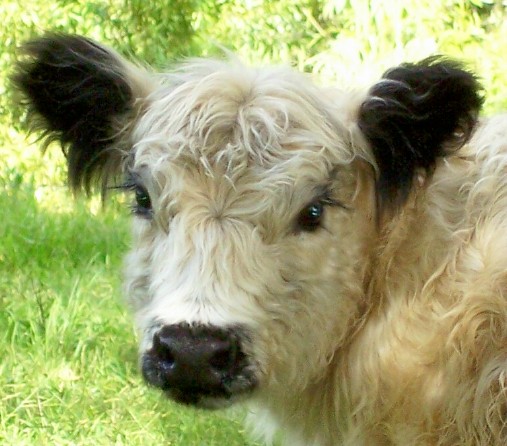
A 12 mth old pure bred heifer. From full blood cow and pure bred bull Cannon Boy.

